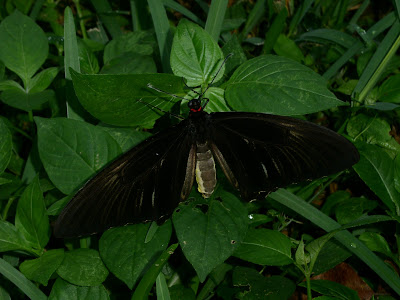The butterfly trail at the Alexandra Hospital is, in my honest opinion, one of the best places to look for butterflies. The commoner species like the emigrants and bush browns flutter in abundance there, together with rarer species like the Common Birdwing and Common Rose. Ironically. The names, I mean. So many different host plants are planted all together in one area so it is no wonder that this place is a melting pot of butterflies. And of course, moths. An added bonus is that it is one of the easiest butterfly-spotting sites, in that you don't have to trudge around in humid undergrowth just to see fleeting flashes of coloured wings. Here, the butterflies practically fly into your face.
Here is the life cycle of the magnificent Common Birdwing Troides helena cerberus.
These are my first close-up shots of this butterfly in the wild! Thrilling, yes.

The egg. It is rather large, actually, about 2+mm in diameter.
First or second instar caterpillar. Note the red-tipped fleshy spines.
Mid-stage caterpillars. The caterpillars are, as can be seen, wonderfully velvety and fleshy, and they photograph well!
Caterpillar with the orange-red osmeterium everted to deter would-be predators. The osmeterium is a fleshy, forked organ that the caterpillar extrudes when it feels threatened, emitting a putrid odour.
Final instar caterpillar. At this point, the caterpillar is incredibly large.
Larva in pre-pupal stage, hanging via a silk girder to the stem of its host plant.
The beautiful bright green pupa hangs from a stem, camouflaging itself as a leaf surprisingly well despite its bulk.
The resplendent adult butterfly, in this case a female, resting on grass after being relentlessly pursued by a male.

































